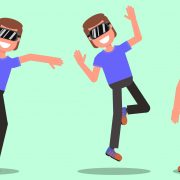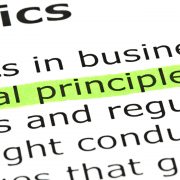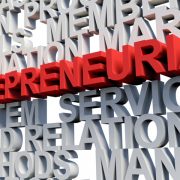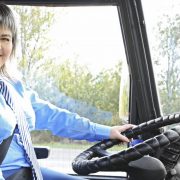What can an individual accomplish in a system as vast as the US economy or the global economy? Don’t we need systems and institutions and scale to accomplish anything these days? Isn’t the individual a cog in the machine?
The clear answer is no, and the no is becoming more emphatic. A new infrastructure of individualism is emerging to augment the capability of one person to impact the world. Here are some of the elements of the infrastructure.
Clouds Of General Rules.
F.A. Hayek put forward the proposition that creative and productive systems work best when there is a shared set of general rules that are known to everyone and apply to everyone, and the freedom for individuals to try their hardest to succeed within the framework of those rules. Today, cloud computing and cloud services are digitizing Hayek’s system. Think of 3D printing, for example. There are recipes and general rules for printing in the cloud. Anyone with a 3D printer and an internet connection can utilize the general rules, make a local adjustment based on their individual creativity, and produce a unique artifact, or a series of differentiated ones.
A paralegal can access the cases and precedents stored for everyone in the cloud, and apply their own knowledge and creativity to ranking the top cases for the support of the specific defense or prosecution they wish to make. A researcher can access analytical tools and algorithms in the cloud to apply to their own data set in order to arrive at a singular insight. We can think of 3D printing recipes, data storage and analytical tools as augmentation of our individual knowledge. Knowledge and tools will be broadly available; the whole world will be contributing to this cloud cache of rules; our individual creativity will make the difference in how we utilize them.
Miniaturized Rule Translators.
To help us translate the general rules and knowledge in the cloud into our own creative applications, there will be a host of innovative machines, IoT sensors and processors, miniature factories and farms, batteries and chips and devices. These machines will process the cloud knowledge and data, and allow for local adjustment and additions and combinations. This is the ultimate empowerment for individuals. Think of solar panels translating the rules of energy generation to turn your house into a power plant. Think of the batteries you can now buy to store that energy and further enhance your self-sufficiency. Think of the driverless cars that will translate the rules of the road, and the data-experience of trillions of journeys by hundreds of millions of people, into safe commutes. Think of the video cameras and local software you use to record personalized content that is sent into the cloud as data for rendering. Individuals are empowered to act locally, and utilize the knowledge of the world in the cloud and on networks.
Cognitive Assistants.
Beyond just the translation of rules, we are at the beginning of the era of the low cost, high performance AI-powered cognitive assistant. These software + hardware helpers will bring us not only knowledge, but intelligence. A medical cognitive assistant can work beside individual EMS personnel in an ambulance to scan the brain of a stroke victim and inform the doctor at the hospital of the kind of blockage (compared with a database of past stroke victims) and the specific type of thrombectomy that should be performed. Cognitive Systems Institute lists computer and information research scientists, human factors engineers, sociologists, mathematicians, statisticians and engineers among the professions that can already be augmented by cognitive assistants, with many to follow.
While waiting for our cognitive assistant to arrive, we can already utilize the vast amount of cognitive assistance built in to the Google search bar, Google Maps and other readily downloadable apps that are already providing individual access to artificial intelligence and machine learning. The quality of the questions we ask will determine the utility of the results we get.
Step Across The Threshold Of Universal Access.
It is reasonable to think and act on the basis that no access is denied to us. Access to people, knowledge, tools, learning, insight, technology is fully available. Now, that may not be completely the case, but things are certainly moving in that direction. Historically, preferred access was one of the ways that the few made life difficult for the many. Today, with the use of the appropriate tools, there are few access barriers we can’t navigate around.
Global exchange platforms grant us access to markets all over the world. We can connect to buyers and to vendors. We can trade currencies. We can assemble supply chains from our desktops. We can contract fulfillment services to deliver goods from across the world to our own doorstep or one in our neighborhood. We can access research papers, API’s, software, algorithms, and books. We can reach out to people, and do so in the context of LinkedIn or academia.edu or match.com. If we can’t make an immediate connection, we can identify someone who knows someone who knows someone and take a roundabout route.
Any single individual can reasonably expect to access any other individual, any piece of knowledge, any tool, or any sub-system.
Reconfigurable Organizations.
With all of this augmentation, what limitations remain? One of the traditional answers is that the individual entrepreneur can not tap the power of organization – the hierarchical firm or corporation can harness the power of organization in ways that individuals and small group can not. That limitation is now also removed in the world of individual augmentation. New organizational forms are emerging for individuals and groups to assemble teams and resources on a project-specific basis. You can recruit the individuals you need on the team, with the most specific skill sets and experiences, and assemble the resources to support them, co-ordinating virtually and digitally. You can assemble the team in a WeWork office or on zoom or some other form of collaborative software, run team communications and digital asset sharing on Slack, and manage the process on software like Appian or one of many other alternatives. You can bring on new contributors when needed, and those that have finished their specific task can leave and go on to the next one. The new organization is configurable and reconfigurable at will, and in response to specific project steps and tasks.
Unlimited Potential.
None of this comes without effort. It’s hard work to compete as an individual practitioner. But, increasingly, the technologies of individual augmentation are pushing the boundaries of what one entrepreneur can accomplish.













